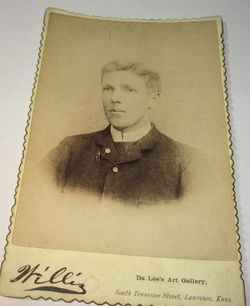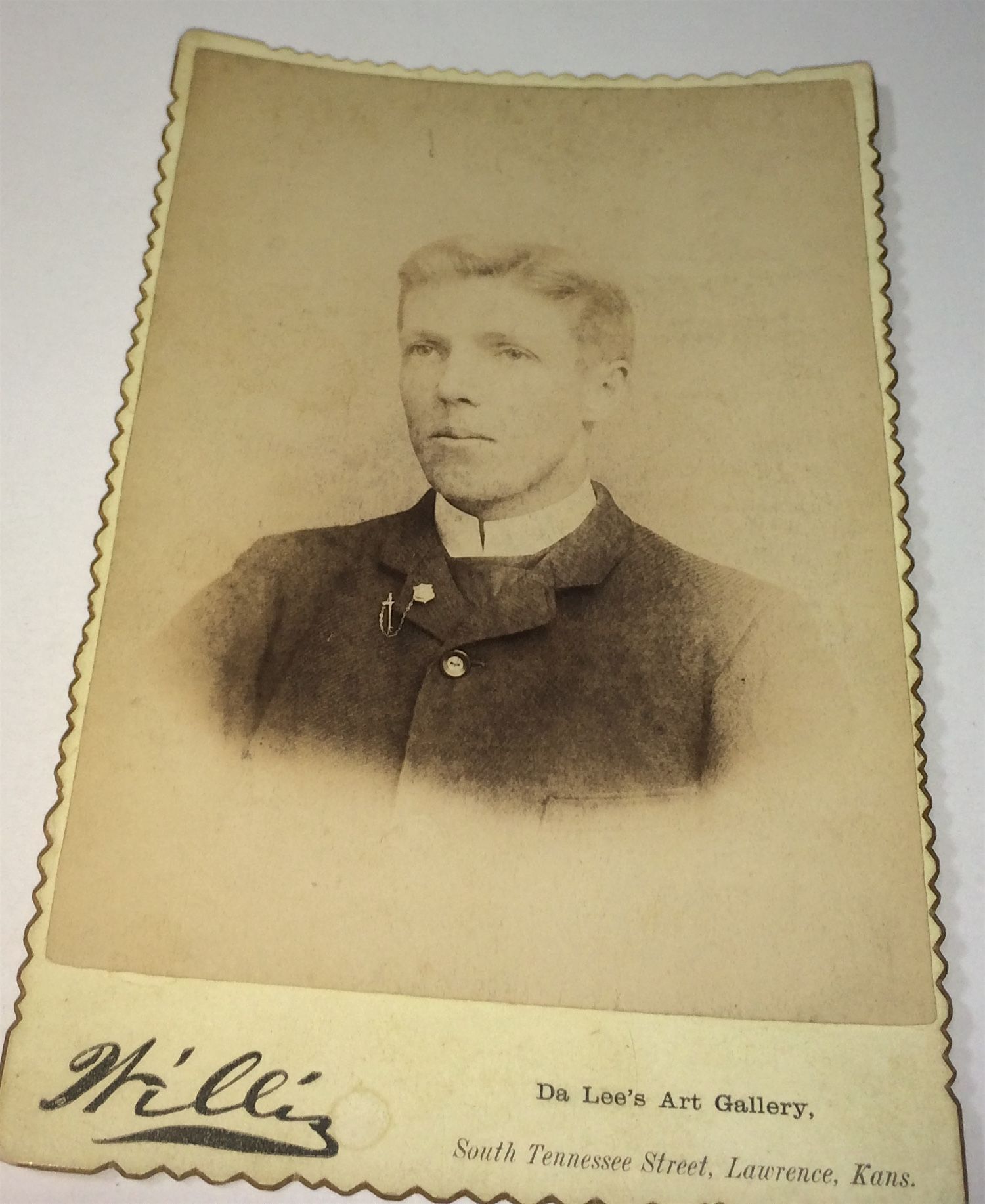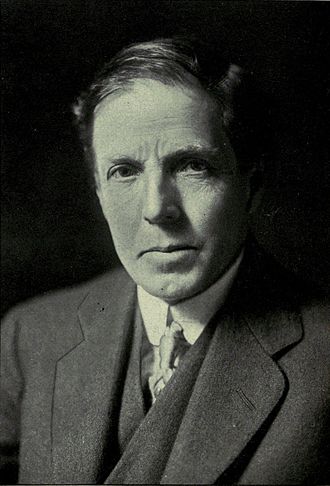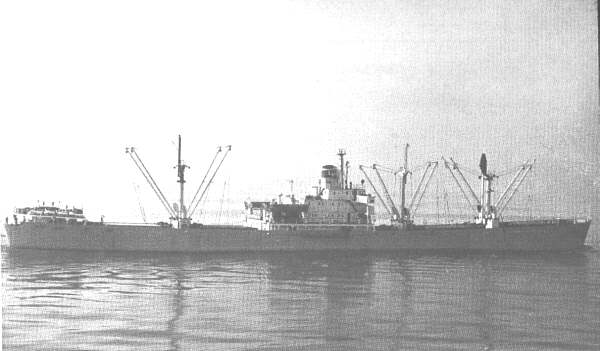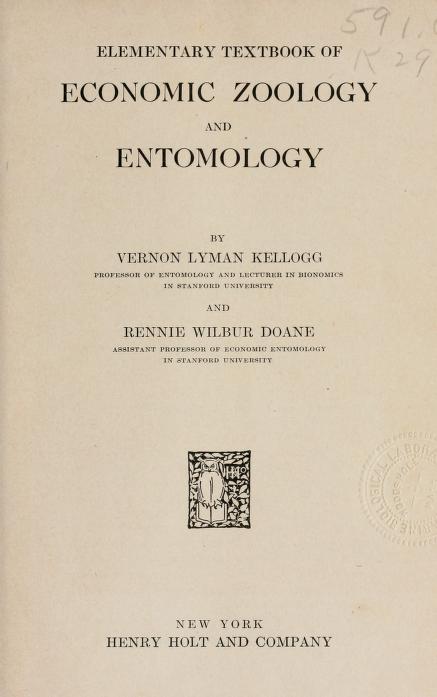*****************************************
The Emporia [KS] Gazette, 09 Aug 1937, Monday
VERNON L. KELLOGG DEAD
Former Emporian, Distinguished Scientist and Author, Dies in Hartford, Conn.
Hartford, Conn., Aug. 9 (AP)--Dr. Vernon Lyman Kellogg, distinguished scientist and author, died today at the Neuro-Psychiatric hospital and institute. He was 69 years old.
Memorial services will be held Tuesday afternoon in the Trinity college chapel.
Dr. Kellogg became the first permanent secretary of the National Research council at Washington in 1919 and held the position until forced to resign by illness in 1931. He was instrumental in extending relationships of the council among colleges and universities.
Heredity, biology and evolution were the chief subjects covered by his book and papers.
STUDIED BIRDS IN KANSAS.
He began his scientific career by studying birds in Kansas, where his father, Lyman B. Kellogg, was at one time attorney general. Dr. Kellogg was born at Emporia.
At Kansas university he associated with the scientist, E. B. Franklin and Gen. Frederick Funston. He worked under the famous entomologist, Comstock, at Cornell university and then studied at Leipzig.
Shortly after David Starr Jordan started Stanford university, young Kellogg arrived to teach entomology and carry on biological research with silk worms. He was at Stanford about 25 years.
When Herbert Hoover organized the Belgian relief commission, Kellogg was one of the first to volunteer to assist, and from the beginning from 1915 worked in various capacities in Europe and in the United States.
HELD MANY MAJOR POSTS.
At one time he served on boards of the Rockefeller Foundation and those of a large number of other scientific and educational institutions, among them the League of Nation's committee for intellectual co-operation.
He was a member of the National Academy of Sciences and an honorary member of British and French scientific societies. He held honorary degrees from American universities and decorations of foreign governments, among them the Belgian Order of Leopold and the Order of the Crown; the French Legion of Honor, and Poland's highest award.
With him at his death were his wife, Charlotte Kellogg; his daughter, Jean Kellogg, and Albert Barrows of the National Research council.
*****************************************
Same Edition
VERNON L. KELLOGG.
Vernon L. Kellogg died Sunday in Hartford, Conn., lacking but a few months of living three score years and 10, and long, full, useful, happy life. He was born in this town. He lived here for 17 years. His childhood and boyhood were spent in Emporia and always his heart was here. Here as a young man he saw his visions and here as an old man he came in fancy to dream his dreams. His was a happy boyhood. It was busy and purposeful. His boyhood foreshadowed his life. Few boys who have grown up in this town have got so much out of his first years as he did. Of course he had this advantage: The earth around about us then was new to the white men. The Indians had gone less than a score of years when he roamed in the woods. The wide woods along the prairie streams, in the bends of the creeks and at the junctions had not fallen before the plow. They were full of birds and little wild animals. Many of the birds are now gone and the little animal life has all but vanished. The prairie sod, much of it, was unturned in the seventies and eighties and the boys in those days roamed like other young mammals through the woods and prairies
* * * *
Vernon and his brother Fred, in their childhood had the tremendous advantage of wise parents who built for the boys an unusual and beautiful home. His father had been first president of the Normal, for many years was probate judge, state senator and later attorney general. His mother died in his infancy and his father married Jennie Mitchell and the two of them surrounded the boys with intelligent love. Neighbors' children romped through the home with muddy boots and riotous noise. But books were there, all kinds of books, novels, boys' books, adventure books, a few wise books. The boys were encouraged to build boats in the back yard. A little house was built for them on the lot where the Kelloggs lived at Eighth and Mechanic, diagonally across from the Congregational church. This little house was their domain. They did not allow anyone to come in to make a bed or sweep out. In it were their very own books and tools and ball bats and the paraphernalia that boys love. Thus always there gathered a group of boys--Irving Morse, Fred Bennett, Dale Plumb, Bob Jones, Ormond Perley, Alex Reeves, a colored boy--reading, wrangling, wrestling, envisioning high things. Then the boys had a cabin on the Kellogg farm on the Neosho, three or four miles east of town. That was a rendezvous of youth. In summers the Kellogg boys and Plumb and Perley, Bennett and Morse and maybe Arthur Milligan rigged up a campers' outfit and went into the hills southwest of town to Jacob's Mound and on and beyond, looking for arrowheads and fossils and traces of Indian life.
* * * *
They lived such lives as boys now know only in envious dreams. They skated and swam, trapped and hunted and fished and studied wildlife until the whole annual panorama of nature with the going and coming of plants and birds and flowers and the passing colors of the grass and trees became a part of their life.
Is it a wonder that such a boy became a scientist? How could he help it? When he left this town to go to the University of Kansas in 1885 at 18, his fate was written inexorably in the blood and environment of his childhood. A college professor's son, Vernon had learned casually to love the outer manifestations of nature. He yearned secretly to study the inner sources of things. In the University he fell in with a group of young men of his own kith and kind. In those days two dominant forces directed the University of Kansas--Dr. Frank Snow, the scientist, Dr. James H. Canfield, the sociologist. Vernon Kellogg got the best out of both. In their classes he meth the two Franklins, Ed and Will, one of whom became a great analytical chemist, the other an electrical physicist of nationwide fame. At the University Kellogg was thrown with Fred Funston and W. E. Borah and Herbert Hadley, a notable group for one school to be nurturing Kellogg, who at that time bore the nickname "V. L.," became a leader, a leader in classroom work, a leader in extra-curricular activities. He could pitch a mean drop curve in the baseball tournament. He also was a smart university politician. He helped to edit the college newspaper and to choose the other editors. He was editor-in-chief of one of them; got Phi Beta Kappa grades and carried away a key when he graduated, was a good dancer and a leader in his college fraternity, Phi Delta Theta. Always a soft-spoken, gentle, diplomatic person, he had his way more by festive intrigue than by force. He rarely appeared in the front of controversial things. But he was there and he ruled.
* * * *
He became secretary to the Chancellor, Dr. Snow, and sat in faculty meetings and was wise beyond his years with the lore of faculty doings which gave him great prestige among the other boys. But his mind was set, not into politics where he might well have succeeded, nor into economics where his grades were splendid. For he was destined to be a scientist and he went to science like a hunter dog for a covey. He studied in Cornell, went to Germany, learned what he could there, came back, taught in Kansas University, went on to Stanford, published books in collaboration with well-known scientists like Dr. Comstock, of Cornell, Dr. Jordan, of Stanford. Kellogg wrote beautifully. During his vacations in the University he worked on the Lawrence Journal, and might have been a good journalist if he had cared for that profession. But what he learned in journalism, indeed what he learned anywhere, he took with him. His life was an accumulation of ten thousand things he had learned in passing through the wilderness of this world. So he was gentle, wise and kind to the end.
* * * *
He left Stanford to go to Europe with Herbert Hoover, became an administrator in the Belgian relief, had heavy responsibility and did splendid service. He never went back to the college classroom. He was elected director of the National Research Council supported by the Carnegie foundation, a sort of clearing house of scientific research and information. He was master in one of the marble buildings south of the White House, near the Monument. Here the great, learned societies of America met and Kellogg supervised their programs, looked after their meetings and was a force to be reckoned with in international learning. He became a member of the American Academy of Science and was respected all over the world where his research was done. He was a world leader in his chosen profession.
* * * *
Then suddenly eight years ago he was stricken with an incurable disease, a paralysis that began with his hands and feet and gradually crept to his heart. He was conscious until a few hours before his death. For eight years he had looked at death and worse than death, inevitable idleness and the failure of much that he had envisioned. But he had encountered it like a man, without blinking. With all his learning, with all his wisdom, with all his gentleness and all the love he bore so many friends, also he had great courage. He was a rounded man with whom God gave a chance to be all that he would have been. Then, by the cruel irony of fate, he had to live on and see live slowly move from him. The power and beauty and joy that he loved so well he was doomed to see fail and fade and fall from his hands. But because he made no outcry he knew at last that he was very brave. For he had lived through death.
And so passed the little boy who padded barefoot along these streets, ran over these hills and swam these streams, who looked at these Kansas skies and saw here the common, lovely visions of youth.--W.A.W. [William Allen White]
-------------------------
Above Biography provided by and posting request by Becky Doan (#46821009)
*****************************************
The Emporia [KS] Gazette, 09 Aug 1937, Monday
VERNON L. KELLOGG DEAD
Former Emporian, Distinguished Scientist and Author, Dies in Hartford, Conn.
Hartford, Conn., Aug. 9 (AP)--Dr. Vernon Lyman Kellogg, distinguished scientist and author, died today at the Neuro-Psychiatric hospital and institute. He was 69 years old.
Memorial services will be held Tuesday afternoon in the Trinity college chapel.
Dr. Kellogg became the first permanent secretary of the National Research council at Washington in 1919 and held the position until forced to resign by illness in 1931. He was instrumental in extending relationships of the council among colleges and universities.
Heredity, biology and evolution were the chief subjects covered by his book and papers.
STUDIED BIRDS IN KANSAS.
He began his scientific career by studying birds in Kansas, where his father, Lyman B. Kellogg, was at one time attorney general. Dr. Kellogg was born at Emporia.
At Kansas university he associated with the scientist, E. B. Franklin and Gen. Frederick Funston. He worked under the famous entomologist, Comstock, at Cornell university and then studied at Leipzig.
Shortly after David Starr Jordan started Stanford university, young Kellogg arrived to teach entomology and carry on biological research with silk worms. He was at Stanford about 25 years.
When Herbert Hoover organized the Belgian relief commission, Kellogg was one of the first to volunteer to assist, and from the beginning from 1915 worked in various capacities in Europe and in the United States.
HELD MANY MAJOR POSTS.
At one time he served on boards of the Rockefeller Foundation and those of a large number of other scientific and educational institutions, among them the League of Nation's committee for intellectual co-operation.
He was a member of the National Academy of Sciences and an honorary member of British and French scientific societies. He held honorary degrees from American universities and decorations of foreign governments, among them the Belgian Order of Leopold and the Order of the Crown; the French Legion of Honor, and Poland's highest award.
With him at his death were his wife, Charlotte Kellogg; his daughter, Jean Kellogg, and Albert Barrows of the National Research council.
*****************************************
Same Edition
VERNON L. KELLOGG.
Vernon L. Kellogg died Sunday in Hartford, Conn., lacking but a few months of living three score years and 10, and long, full, useful, happy life. He was born in this town. He lived here for 17 years. His childhood and boyhood were spent in Emporia and always his heart was here. Here as a young man he saw his visions and here as an old man he came in fancy to dream his dreams. His was a happy boyhood. It was busy and purposeful. His boyhood foreshadowed his life. Few boys who have grown up in this town have got so much out of his first years as he did. Of course he had this advantage: The earth around about us then was new to the white men. The Indians had gone less than a score of years when he roamed in the woods. The wide woods along the prairie streams, in the bends of the creeks and at the junctions had not fallen before the plow. They were full of birds and little wild animals. Many of the birds are now gone and the little animal life has all but vanished. The prairie sod, much of it, was unturned in the seventies and eighties and the boys in those days roamed like other young mammals through the woods and prairies
* * * *
Vernon and his brother Fred, in their childhood had the tremendous advantage of wise parents who built for the boys an unusual and beautiful home. His father had been first president of the Normal, for many years was probate judge, state senator and later attorney general. His mother died in his infancy and his father married Jennie Mitchell and the two of them surrounded the boys with intelligent love. Neighbors' children romped through the home with muddy boots and riotous noise. But books were there, all kinds of books, novels, boys' books, adventure books, a few wise books. The boys were encouraged to build boats in the back yard. A little house was built for them on the lot where the Kelloggs lived at Eighth and Mechanic, diagonally across from the Congregational church. This little house was their domain. They did not allow anyone to come in to make a bed or sweep out. In it were their very own books and tools and ball bats and the paraphernalia that boys love. Thus always there gathered a group of boys--Irving Morse, Fred Bennett, Dale Plumb, Bob Jones, Ormond Perley, Alex Reeves, a colored boy--reading, wrangling, wrestling, envisioning high things. Then the boys had a cabin on the Kellogg farm on the Neosho, three or four miles east of town. That was a rendezvous of youth. In summers the Kellogg boys and Plumb and Perley, Bennett and Morse and maybe Arthur Milligan rigged up a campers' outfit and went into the hills southwest of town to Jacob's Mound and on and beyond, looking for arrowheads and fossils and traces of Indian life.
* * * *
They lived such lives as boys now know only in envious dreams. They skated and swam, trapped and hunted and fished and studied wildlife until the whole annual panorama of nature with the going and coming of plants and birds and flowers and the passing colors of the grass and trees became a part of their life.
Is it a wonder that such a boy became a scientist? How could he help it? When he left this town to go to the University of Kansas in 1885 at 18, his fate was written inexorably in the blood and environment of his childhood. A college professor's son, Vernon had learned casually to love the outer manifestations of nature. He yearned secretly to study the inner sources of things. In the University he fell in with a group of young men of his own kith and kind. In those days two dominant forces directed the University of Kansas--Dr. Frank Snow, the scientist, Dr. James H. Canfield, the sociologist. Vernon Kellogg got the best out of both. In their classes he meth the two Franklins, Ed and Will, one of whom became a great analytical chemist, the other an electrical physicist of nationwide fame. At the University Kellogg was thrown with Fred Funston and W. E. Borah and Herbert Hadley, a notable group for one school to be nurturing Kellogg, who at that time bore the nickname "V. L.," became a leader, a leader in classroom work, a leader in extra-curricular activities. He could pitch a mean drop curve in the baseball tournament. He also was a smart university politician. He helped to edit the college newspaper and to choose the other editors. He was editor-in-chief of one of them; got Phi Beta Kappa grades and carried away a key when he graduated, was a good dancer and a leader in his college fraternity, Phi Delta Theta. Always a soft-spoken, gentle, diplomatic person, he had his way more by festive intrigue than by force. He rarely appeared in the front of controversial things. But he was there and he ruled.
* * * *
He became secretary to the Chancellor, Dr. Snow, and sat in faculty meetings and was wise beyond his years with the lore of faculty doings which gave him great prestige among the other boys. But his mind was set, not into politics where he might well have succeeded, nor into economics where his grades were splendid. For he was destined to be a scientist and he went to science like a hunter dog for a covey. He studied in Cornell, went to Germany, learned what he could there, came back, taught in Kansas University, went on to Stanford, published books in collaboration with well-known scientists like Dr. Comstock, of Cornell, Dr. Jordan, of Stanford. Kellogg wrote beautifully. During his vacations in the University he worked on the Lawrence Journal, and might have been a good journalist if he had cared for that profession. But what he learned in journalism, indeed what he learned anywhere, he took with him. His life was an accumulation of ten thousand things he had learned in passing through the wilderness of this world. So he was gentle, wise and kind to the end.
* * * *
He left Stanford to go to Europe with Herbert Hoover, became an administrator in the Belgian relief, had heavy responsibility and did splendid service. He never went back to the college classroom. He was elected director of the National Research Council supported by the Carnegie foundation, a sort of clearing house of scientific research and information. He was master in one of the marble buildings south of the White House, near the Monument. Here the great, learned societies of America met and Kellogg supervised their programs, looked after their meetings and was a force to be reckoned with in international learning. He became a member of the American Academy of Science and was respected all over the world where his research was done. He was a world leader in his chosen profession.
* * * *
Then suddenly eight years ago he was stricken with an incurable disease, a paralysis that began with his hands and feet and gradually crept to his heart. He was conscious until a few hours before his death. For eight years he had looked at death and worse than death, inevitable idleness and the failure of much that he had envisioned. But he had encountered it like a man, without blinking. With all his learning, with all his wisdom, with all his gentleness and all the love he bore so many friends, also he had great courage. He was a rounded man with whom God gave a chance to be all that he would have been. Then, by the cruel irony of fate, he had to live on and see live slowly move from him. The power and beauty and joy that he loved so well he was doomed to see fail and fade and fall from his hands. But because he made no outcry he knew at last that he was very brave. For he had lived through death.
And so passed the little boy who padded barefoot along these streets, ran over these hills and swam these streams, who looked at these Kansas skies and saw here the common, lovely visions of youth.--W.A.W. [William Allen White]
-------------------------
Above Biography provided by and posting request by Becky Doan (#46821009)
Family Members
Sponsored by Ancestry
Advertisement
Advertisement
